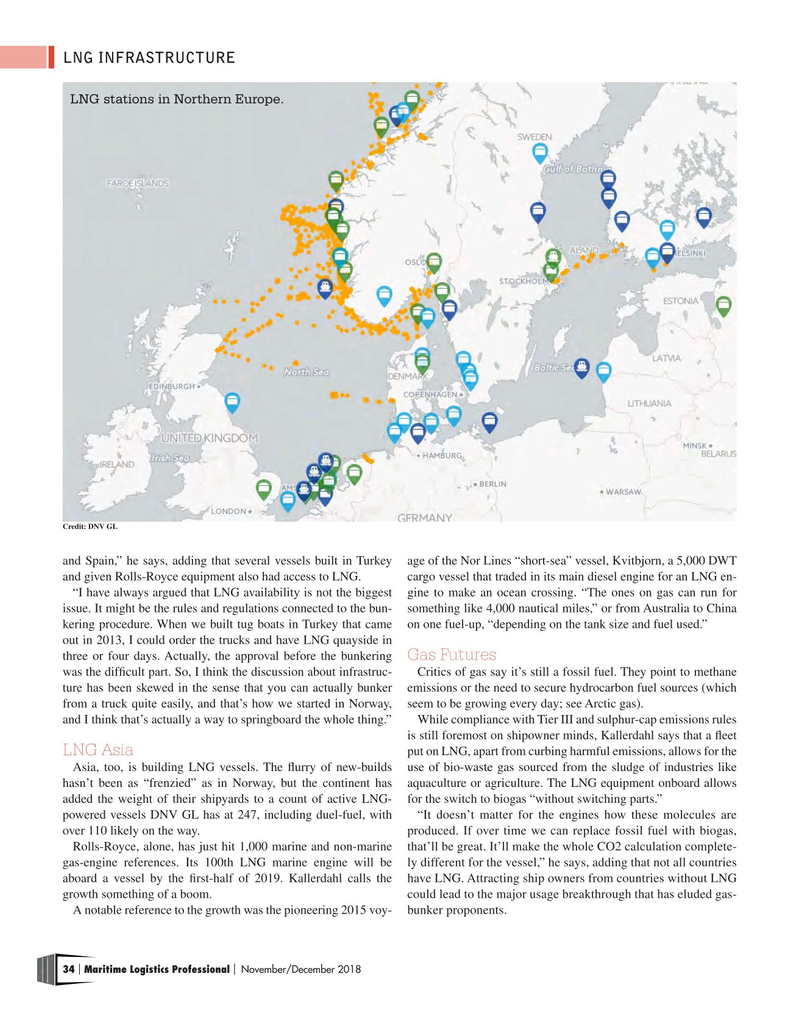
Page 34: of Maritime Logistics Professional Magazine (Nov/Dec 2018)
Regulatory & Environmental Review
Read this page in Pdf, Flash or Html5 edition of Nov/Dec 2018 Maritime Logistics Professional Magazine
LNG INFRASTRUCTURE
LNG stations in Northern Europe.
Credit: DNV GL and Spain,” he says, adding that several vessels built in Turkey age of the Nor Lines “short-sea” vessel, Kvitbjorn, a 5,000 DWT and given Rolls-Royce equipment also had access to LNG. cargo vessel that traded in its main diesel engine for an LNG en- “I have always argued that LNG availability is not the biggest gine to make an ocean crossing. “The ones on gas can run for issue. It might be the rules and regulations connected to the bun- something like 4,000 nautical miles,” or from Australia to China kering procedure. When we built tug boats in Turkey that came on one fuel-up, “depending on the tank size and fuel used.” out in 2013, I could order the trucks and have LNG quayside in three or four days. Actually, the approval before the bunkering Gas Futures was the diffcult part. So, I think the discussion about infrastruc- Critics of gas say it’s still a fossil fuel. They point to methane ture has been skewed in the sense that you can actually bunker emissions or the need to secure hydrocarbon fuel sources (which from a truck quite easily, and that’s how we started in Norway, seem to be growing every day; see Arctic gas). and I think that’s actually a way to springboard the whole thing.” While compliance with Tier III and sulphur-cap emissions rules is still foremost on shipowner minds, Kallerdahl says that a feet
LNG Asia put on LNG, apart from curbing harmful emissions, allows for the
Asia, too, is building LNG vessels. The furry of new-builds use of bio-waste gas sourced from the sludge of industries like hasn’t been as “frenzied” as in Norway, but the continent has aquaculture or agriculture. The LNG equipment onboard allows added the weight of their shipyards to a count of active LNG- for the switch to biogas “without switching parts.” powered vessels DNV GL has at 247, including duel-fuel, with “It doesn’t matter for the engines how these molecules are over 110 likely on the way. produced. If over time we can replace fossil fuel with biogas,
Rolls-Royce, alone, has just hit 1,000 marine and non-marine that’ll be great. It’ll make the whole CO2 calculation complete- gas-engine references. Its 100th LNG marine engine will be ly different for the vessel,” he says, adding that not all countries aboard a vessel by the frst-half of 2019. Kallerdahl calls the have LNG. Attracting ship owners from countries without LNG growth something of a boom. could lead to the major usage breakthrough that has eluded gas-
A notable reference to the growth was the pioneering 2015 voy- bunker proponents. 34 Maritime Logistics Professional November/December 2018 | |

 33
33

 35
35
